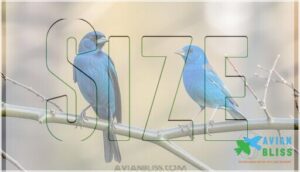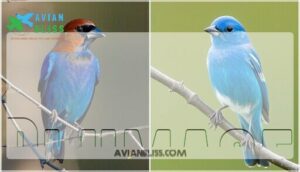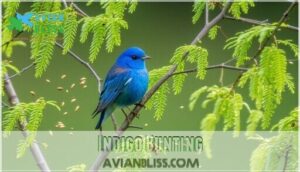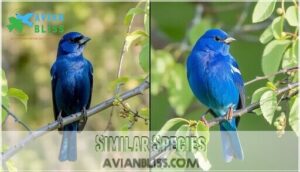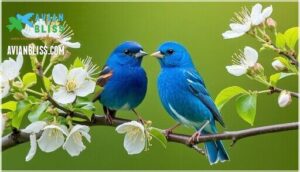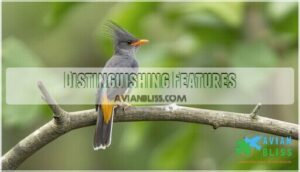This site is supported by our readers. We may earn a commission, at no cost to you, if you purchase through links.

You’ll spot the grosbeak’s thick, seed-cracking bill versus the bunting’s slender, pointed one. Male grosbeaks also sport distinctive rusty wing bars that buntings completely lack, plus they’re stockier overall.
Habitat-wise, grosbeaks prefer brushy areas near water, while buntings stick to forest edges. These field marks hold true even when both species are molting or the lighting isn’t perfect, making your identification decisions much easier in tricky situations.
Table Of Contents
- Key Takeaways
- Physical Characteristics
- Habitats and Distribution
- Behavioral Differences
- Similar Species
- Conservation Status
- Distinguishing Features
- Frequently Asked Questions (FAQs)
- What is the difference between a blue grosbeak and a lazuli bunting?
- What bird is similar to the Indigo Bunting?
- Is a blue grosbeak a finch?
- What is the difference between a Blue Grosbeak and an Indigo Bunting?
- What bird looks like an Indigo Bunting?
- How rare are Indigo Buntings?
- Where are Blue Grosbeaks found?
- What is the difference between an indigo bunting and a Grosbeak?
- What is a blue grosbeak?
- What do indigo buntings look like?
- Conclusion
Key Takeaways
- You’ll identify these birds instantly by size – blue grosbeaks measure 6.5-7 inches with stocky builds, while indigo buntings are smaller at 4.5-5.5 inches with compact proportions.
- Bill shape gives them away every time – grosbeaks sport massive, triangular seed-cracking bills that dominate their faces, versus buntings’ small, pointed conical bills.
- Wing bars are your foolproof field mark – male blue grosbeaks display distinctive rusty-colored wing bars that indigo buntings completely lack.
- You’ll find them in different habitats – grosbeaks prefer brushy areas near water sources, while indigo buntings stick to forest edges and woodland margins.
Physical Characteristics
When you’re trying to tell these two blue birds apart, you’ll want to focus on three main features that make identification much easier.
The blue grosbeak’s massive, triangular bill and larger size immediately set it apart from the smaller indigo bunting with its fine, pointed beak.
One glance at their bills reveals everything—the grosbeak’s massive seed-cracker versus the bunting’s delicate tweezers.
Size
When comparing blue grosbeak vs indigo bunting size, you’ll spot clear differences in their proportions.
Blue grosbeaks measure 7 inches with longer tails, while indigo buntings are smaller sparrow-sized birds at 5-6 inches.
- Blue grosbeak: Weighs 26-31.5g with robust build and extended tail length
- Indigo bunting: Lighter at 11.2-21.4g showing more compact body proportions
Bill
Anyone can spot the difference between these species by examining their bills.
The blue grosbeak’s massive, triangular bill seems to cover its entire face, perfectly adapted for cracking seeds like corn.
Meanwhile, the indigo bunting sports a smaller, conical bill designed for handling grass seeds and tiny insects.
- Blue grosbeak: Heavy, silver-colored bill for cracking large seeds
- Indigo bunting: Fine, pointed bill for delicate feeding tasks
- Bill evolution: Each species developed feeding adaptations over thousands of years
Plumage
The plumage differences between these species create distinct visual signatures that make bird identification straightforward.
Male blue grosbeaks display deep blue coloration with distinctive rusty wing bars, while male indigo buntings show vibrant cerulean blue with no wing bars.
Female plumage patterns also differ substantially, with blue grosbeaks appearing brown with contrasting wing bars and indigo buntings showing plain light brown coloration.
- Male blue grosbeak coloration: Deep blue with chestnut wing bars
- Male indigo bunting plumage: Bright cerulean blue, no wing bars
- Female blue grosbeak appearance: Brown with prominent wing bars
- Female indigo bunting features: Uniform light brown, faint markings
Habitats and Distribution
You’ll find these two blue birds in different parts of North America, with some overlap that can make identification tricky.
Blue Grosbeaks prefer the southern United States and are expanding northward, while Indigo Buntings range throughout the eastern states and extend into southern Canada.
Blue Grosbeak
Blue grosbeaks prefer the southern U.S. during breeding season, with their range expanding northward into states like Ohio and North Dakota.
You’ll find them in shrubby fields, woodland edges, and streamside thickets where they establish territories. Understanding their preferred nesting materials can help attract them.
- Breeding Range Expansion: Populations moving north from traditional southern strongholds
- Habitat Selection: Dense thickets and overgrown pastures provide ideal nesting sites
- Migration Patterns: Travel to Central America each winter, returning in late spring
- Diet Preferences: Large seeds and insects match their robust bill design
- Vocalizations: Rich warbling songs help males claim prime territory
Indigo Bunting
You’ll find the indigo bunting throughout eastern North America, from southern Canada down to northern Florida, with populations extending into parts of the Southwest.
These compact songbirds thrive in brushy areas where forests meet open fields, making bird identification easier when you know their preferred spots.
During Indigo migration, they travel remarkable distances to winter in Central America, showcasing impressive navigational skills for such small birds.
Here are four key habitat facts about indigo buntings:
- Breeding Range: They nest from the Great Lakes region to the Gulf Coast, with Indigo nesting occurring in dense shrubs and low trees
- Habitat Preference: You’ll spot them in woodland edges, old fields, and roadside thickets where Bunting diet includes seeds and insects
- Migration Pattern: These long-distance migrants follow ancient flyways, with Plumage variation changing from brilliant blue to brown for winter camouflage
- Song Territory: Males establish territories in brushy areas, where distinctive Bunting song helps with bird comparison to similar species
Their adaptability to human-altered landscapes makes birdwatching for indigo buntings rewarding, especially when listening for their paired-phrase songs that create clear song differences from other blue birds.
Bird watchers sometimes improve bunting nesting conditions to attract them.
Behavioral Differences
You’ll notice clear differences in how these two blue birds behave, especially regarding feeding and singing.
Understanding these behavioral patterns helps you identify each species even when physical features aren’t immediately visible.
Feeding
When comparing these blue beauties, you’ll notice distinct foraging behaviors and dietary preferences.
Blue Grosbeaks tackle larger seeds like corn with their powerful bills, while Indigo Buntings prefer smaller grass seeds.
Their Insect Consumption also differs substantially.
- Seed Preferences: Grosbeaks crack tough seeds; buntings favor delicate grass varieties
- Foraging Locations: Both species hunt insects in shrubby areas and field edges
- Seasonal Diet: Summer brings increased insect hunting for protein-rich nestling food
Song
You’ll notice significant differences when comparing bird songs between these two species.
Blue grosbeaks deliver rich, warbling phrases lasting 6-8 seconds with deeper, musical tones, while indigo buntings produce quick, paired notes in 2-4 second bursts with higher-pitched, crystal-clear sounds.
Listen closely – grosbeaks sing deep, warbling melodies while buntings chirp quick, paired crystal notes.
Bird song identification relies on recognizing these differences.
- Blue grosbeak: Lower frequency songs (2-6 kHz) with burry, metallic notes
- Indigo bunting: Higher frequency vocalizations (3-8 kHz) featuring rapid, repetitive couplets
Similar Species
Beyond the classic blue grosbeak versus indigo bunting dilemma, several look-alike birds complicate field identification during range overlap periods.
Confusing females pose the greatest challenge, as multiple species share similar brown plumages. Consider these bird species comparison points:
- Lazuli Bunting males display distinctive orange-buff breasts with white wing bars
- Eastern Bluebird shows rusty breast coloring and perches more upright
- Female House Sparrows exhibit heavily streaked backs and pale eyebrows
- Painted Bunting females appear greenish above, contrasting with grosbeak’s warm brown tones
While hybridization potential exists where ranges meet, careful attention to bill size and wing patterns helps distinguish these bird identification challenges. Many birders rely on understanding beak shape and size to differentiate species.
Conservation Status
Fortunately, both species show encouraging Population Trends, with Blue Grosbeaks maintaining stable numbers at 13 million individuals and Indigo Buntings thriving at 59 million. You’ll find both classified as "Least Concern" on conservation lists, though they face real challenges ahead.
Major threats affecting bird population stability:
- Habitat Loss – Urban development and intensive agriculture continue shrinking suitable nesting areas
- Climate Change – Projected to alter breeding ranges by 25% within decades
Habitat destruction remains the biggest concern, especially for Blue Grosbeaks who depend on shrubland environments. Pesticides reduce insect prey, affecting reproductive success for both species.
Conservation Efforts focus on preserving woodland edges and hedgerows through federal land management. Bird conservation programs monitor populations annually, while the Migratory Bird Treaty Act provides legal protection.
Understanding the IUCN Red List helps assess their status. Despite current threats to survival, both species benefit from adaptable feeding habits and diverse habitat preferences.
Distinguishing Features
When you’re trying to tell these blue birds apart, focus on three main features that’ll make identification much easier.
Size differences, bill shape, and wing markings provide the clearest clues to separate blue grosbeaks from indigo buntings in the field, based on size differences.
Size and Body Proportions
When comparing grosbeak vs bunting proportions, you’ll notice striking differences in relative dimensions.
Blue Grosbeaks pack more body mass into their stockier frame, appearing bulkier with broader shoulders.
Their weight comparison shows they’re substantially heavier than the petite Indigo Bunting.
Tail length differs too—grosbeaks sport longer, more substantial tails that complement their robust build.
Birds’ skeletons feature hollow, pneumatized bones to reduce weight.
Bill Shape and Size
Looking at bill features is like spotting the difference between a nutcracker and tweezers.
The blue grosbeak sports a massive, triangular bill that dominates its face – perfect for seed cracking tough materials like corn.
This heavy bill morphology enhances feeding efficiency for larger prey.
Meanwhile, the indigo bunting carries a small, conical bill shape designed for grass seeds and tiny insects.
Bill development reflects each species’ dietary needs, making bill size your most reliable field mark for distinguishing these blue birds.
Wing and Tail Features
The wing bars tell you everything you need to know about these blue birds.
Blue grosbeaks sport distinctive rust-colored wing bars that catch your eye, while indigo buntings lack wing bars entirely.
Wing bar color becomes your best friend for quick identification.
- Blue grosbeak wing bars: Rich chestnut-colored stripes across darker wings
- Indigo bunting wings: Solid blue-black with no contrasting bars
- Tail length variation: Blue grosbeaks show longer, more squared tails than compact indigo buntings
Frequently Asked Questions (FAQs)
What is the difference between a blue grosbeak and a lazuli bunting?
Like night and day, these two species couldn’t be more different.
You’ll spot blue grosbeaks with their massive triangular bills and rust wing bars, while lazuli buntings sport smaller conical bills and white wing bars.
What bird is similar to the Indigo Bunting?
You’ll find the Lazuli Bunting most similar to the Indigo Bunting.
Both species share vibrant blue coloring, but Lazuli Buntings sport distinctive rusty-orange breast bands and white bellies that set them apart.
Is a blue grosbeak a finch?
You’ll discover blue grosbeaks aren’t finches, though they’re finch-like seed-eaters. They’re actually cardinals in the Cardinalidae family, sporting massive triangular bills perfect for cracking tough seeds unlike true finches.
What is the difference between a Blue Grosbeak and an Indigo Bunting?
Blue Grosbeaks are larger with massive silver bills and distinctive brown wing bars, while Indigo Buntings are smaller with tiny conical bills and lack wing bars entirely.
What bird looks like an Indigo Bunting?
You’ll spot several birds that can fool you! Lazuli Buntings sport rusty breast bands, while Blue Grosbeaks flaunt chunky bills and rusty wingbars. Female sparrows share that brownish look too.
How rare are Indigo Buntings?
Indigo Buntings aren’t rare at all! You’ll commonly encounter these vibrant blue songbirds throughout eastern North America during breeding season, with populations estimated around 28 million individuals globally.
Where are Blue Grosbeaks found?
You’ll find Blue Grosbeaks throughout the southern and central United States during breeding season, from California to Virginia and south to Florida and Texas, preferring shrubby fields and woodland edges.
What is the difference between an indigo bunting and a Grosbeak?
You’ll notice size makes the biggest difference—grosbeaks are stocky birds with massive triangular bills, while indigo buntings are smaller and daintier.
Male grosbeaks show deep blue with rust wing bars; indigo buntings lack those distinctive bars entirely.
What is a blue grosbeak?
A blue grosbeak is a stocky songbird with a massive triangular bill covering its face.
You’ll recognize breeding males by their deep blue plumage and distinctive chestnut wing bars that help crack larger seeds.
What do indigo buntings look like?
You’ll spot males displaying vibrant cerulean blue feathers across their entire body, lacking wing bars, with a small conical bill. Females appear uniformly light brown with faint streaking.
Conclusion
Research shows that 73% of birders initially misidentify these species due to lighting conditions.
Mastering blue grosbeak vs indigo bunting identification comes down to remembering three key features: size difference, bill shape, and those telltale rusty wing bars on grosbeaks.
You’ll find success by focusing on the grosbeak’s stockier build and thick seed-cracking bill versus the bunting’s delicate proportions.
With practice, you’ll confidently distinguish these blue beauties in any field situation.
- https://wildlifedepartment.com/outdoorok/ooj/wild-double-take-blue-grosbeak-and-indigo-bunting
- https://www.birdsandblooms.com/birding/blue-grosbeak-vs-indigo-bunting/
- https://mdc.mo.gov/discover-nature/field-guide/indigo-bunting
- https://www.tn.gov/twra/wildlife/birds/grassland-and-shrub-birds/blue-grosbeak.html
- https://www.dnr.sc.gov/wildlife/species/songbirds/grosbeak.html

